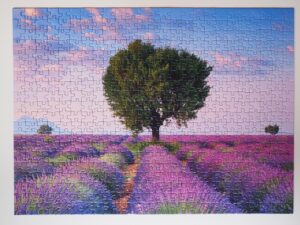Posts by Emilie-Noelle Provost
Books have been getting a lot of bad press lately. According to Penn America’s website, pen.org, more than 16,000 book bans have been implemented in U.S. public schools since 2021, 4,000 of which occurred in the 2023-2024 school year alone—more than at any other time since the McCarthy era of the 1950s. Public libraries have been under assault as well, with many people questioning their relevance and even advocating for their closure.
Estimates vary as to when books as we know them were first produced, but for the majority of time since the middle of the 15th century, when the invention of the printing press made them available to common people, books were considered precious objects by those who owned them.
The idea that books were treasures held true well into the 20th century, a fact I was reminded of recently when I pulled a few antique volumes off of a shelf in my living room. These clothbound gems, a couple of which were published in the mid-1800s, are marvels to behold.
The first in a two-volume set, Ruins of Ancient Cities by Charles Bucke, published in 1848 by Harper & Brothers of New York, features a detailed etching of ancient Athens across from its title page. The indentations made by the printing press on the book’s pages can still be seen if you look at its elegant serif typeset at just the right angle, a reminder that someone painstakingly set the type for all 360 pages by hand, a feat of craftsmanship few people living today could accomplish without error.
Perhaps even more impressive is Everyman’s Library: A Short Biographical Dictionary of English Literature by John W. Cousin. Published by E.P. Dutton & Co. of New York in 1910, the book’s endpapers feature a gorgeous, scrolling Edwardian design complete with a rendering of the Roman goddess Flora who symbolizes abundance. The publisher’s advertisement for the rest of the Everyman series at the beginning of the book is just as lovely, its type arranged to resemble a stylized tulip.
In my mind’s eye, I can picture the families who once owned these books, sitting in their living rooms, reading passages to one another aloud. Back when these hardcovers were published, reading often felt like an adventure. These books were prized possessions, not just because of their content, but because they were well made, beautiful to look at, and expensive to buy. Books like these said something about the people on whose shelves they were stored.
With their flimsy cover stock and recycled paper pages, modern-day print books, by contrast, often feel disposable. And although they are convenient to buy and read, and better for the environment, electronic books are like ghosts even in comparison to these, gone at the touch of a button.
Of course, the format of modern books makes them affordable and widely available to large numbers of readers. And the myriad types of other media readily accessible online makes it unlikely that books will ever regain the status they once enjoyed on a large scale.
Not unlike the American Arts and Crafts movement of the late 19th and early 20th centuries—a […]
Read More
Although part of me is convinced it’s still August, the Halloween season is upon us. After a couple of months of less regimented summer days, the cooler fall weather always brings with it a return to my regular work schedule. As a writer, this in part means a return to researching subjects I want to incorporate into my novels, stories, essays, and articles to make sure I get the details right.
In honor of this spooky time of year, I wanted to share some resources I’ve used in the past to learn about mystical and eerie topics. I hope you won’t find them too terrifying.
Divination and Fortune Telling
Human beings have been trying to predict the future for nearly as long as we’ve been on the planet. Over time, these practices, collectively referred to as divination, have taken many forms.
When it comes to making predictions for individuals, perhaps no method is as widely used as tarot card reading. One of the most straightforward online resources I’ve found for learning about the cards and their history is this HowStuffWorks article from 2023. There are also several good resources available online that explain the individual meanings of each card.
Other methods used to gain insight into the future include reading tea leaves, casting bones, scrying, and using an Ouija Board. Llewellyn’s Complete Book of Divination by Richard Webster is a great resource for learning about all of these and others, including tarot cards. The book also provides instructions, so you can try some of them yourself.
Witches Past and Present
According to some sources, our idea of witches being people who embody magical powers dates back to the ancient Greeks. But our modern, Western concept of witches being women dressed in black cloaks and pointed hats using their powers to do harm comes from the Middle Ages, when the Christian church made it its mission to rout out perceived heretics and rival belief systems.
One of the most well known manifestations of this effort is the 15th century tome Malleus Maleficarum, The Hammer of Witches. Steeped in misogyny, the book offered disturbingly detailed instructions for identifying and prosecuting witches, and provided justification for torturing and burning alive thousands of innocent people, mostly women, over the next three centuries. Copies of Malleus Maleficarum are available at many libraries. Or you can download a digital copy for as little as $4.99.
Contemporary witches have it much better than their forbears. Modern witchcraft, much of it based in the Wiccan religion, embraces feminine energy and power. While there is a lot of information out there on the topic, a few things stand out including this fascinating August 2018 article in The New Yorker and this piece published in The Atlantic in March 2020.
Monsters, Cryptids, and Bogeymen
Who can resist a good Sasquatch sighting story? Or a hair-raising tale about El Chupacabra raising havoc in the night? The Monster Spotter’s Guide to North America by Scott Francis has these and much more, including a […]
Read More
In 2016, when the film Manchester by the Sea was released, I went to see it with a friend. The movie, directed by Kenneth Lonergan, tells the story of a reclusive, down-and-out janitor, played by Casey Affleck, who has lost his children in a house fire caused by his own negligence. Depressed and antisocial, he’s forced back into the land of the living after the sudden death of his brother, when he becomes the legal guardian of his teenage nephew.
Although the movie was sad, it spoke volumes about our ability as individuals to overcome almost unbearable circumstances, grounding and humanizing the sort of horrendous catastrophe that is all too often politicized or used to boost ratings by the mainstream media.
As my friend and I were walking out to the car after the movie, my friend said, “If I’d known how depressing that was going to be, I would have stayed home.”
I didn’t mention it at the time, but I loved Manchester by the Sea. I wasn’t the only one. The film was nominated for six Academy Awards and won two: Best Actor and Best Screen Play.
In Poetics, Aristotle’s famous essay on Greek drama, he wrote that the purpose of tragedy is to “arouse sensations of pity and fear, and to purge [the audience] of these emotions so that they leave the theater feeling cleansed and uplifted, with a heightened understanding of the ways of gods and men.”
Anyone who enjoys listening to the blues knows how this works. It’s also the reason that some of the most revered and beloved works of literature in the English language are tragedies.
Because they offer insight into the human condition, often exhibit circumstances that foster societal plight, and promote critical thinking, tragedies were once standard curriculum in high school and college English classes.
In the late 1980s, when I was in high school, we read Shakespeare’s Othello, Hamlet, Macbeth, and Julius Caesar.
As freshmen, we cringed and wrung our hands after learning the fate of Thomas Hardy’s Tess, the protagonist of his masterwork, Tess of the d’Urbervilles. Poor Tess never had much of a chance.
My sophomore year, we spent a week discussing the suicide of Willy Loman, the sad-sack anti-hero of Arthur Miller’s Death of a Salesman.
I’ll never be able to forget Melville’s luckless Billy Bud, hanged by his neck from the yardarm for a crime he didn’t commit, or the murder of Jay Gatsby, F. Scott Fitzgerald’s lovesick millionaire, shot to death in his own swimming pool.
These works of literature and others like them can be tough to get through. But, in my opinion at least, the cultural, ethical, and spiritual enlightenment tragedies offer outweighs any emotional burden they might impart.
And yet, sometime over the last thirty or so years, tragedies fell out of favor. Novels like Of Mice and Men and The Scarlet Letter make up a large percentage of the books that have been banned in certain parts of the country. Perhaps this is a result of the general backlash against anything even remotely intellectual that’s run rampant in the U.S. for the past few decades, […]
Read More
The protagonist in my second novel is a sixteen-year-old boy. Since the book was published in March 2023, the question I’ve been asked most frequently by readers and reviewers, especially men, is how I was able to write a character so drastically different from myself who seems like he could be a real person.
When I was first asked this question, I didn’t have a good answer. I just created a character that felt real to me, I’d say. But after being asked multiple times, I decided to put some thought into it. The tips below are things I regularly do that have helped me make my fictional characters feel like people you might actually meet.
I observe people carefully.
Because I’m an introvert, I’ve always spent a lot of time watching other people, both friends and strangers, often without realizing it. Doing this has allowed me to pick up on subtle traits and habits individual people have, such as the way someone ties their shoes (lefties tend to use the “rabbit ear” method), or the things some people do when they feel stressed or nervous, like repeatedly adjusting their eyeglasses.
Sometimes these traits can be age-specific or more commonly seen in people of a certain gender, culture, or ethnicity. After a lifetime of observing people in my own family, I’ve come to believe that many of these behaviors are inherited or at least “contagious.”
Also important is noticing the way people are dressed. A habitual runner might still have his sweatsuit and sneakers on when he goes grocery shopping. A trial lawyer might always be wearing a tailored suit when she picks her kids up at school. Someone who’s wealthy, or trying to appear so, might carry an expensive handbag when wearing an otherwise unremarkable outfit.
When I sit down with my laptop to work on a novel or story, I think about the characters and what similarities they might have to actual people I know or have seen, and I try to incorporate some of their traits into my characters’ personalities.
I listen to the way people talk.
Because dialogue, both spoken and internal, is an essential part of any fictional story, paying attention to the way actual people talk is important. Someone’s accent, even a complete stranger’s, can often tell you volumes about that person whether you speak to them or not.
Because I have lived in a city that has a large population of immigrants from around the world for the last twenty-plus years, I’ve gotten good at discerning accents. I can tell the difference between a native Spanish speaker from Puerto Rico and one from the Dominican Republic, for example, by their accents when they’re speaking English.
One of the most interesting things about paying close attention to the way people speak is when I hear someone who is trying to hide their accent. I first picked up on this after meeting the wife of a colleague of my husband’s who was from Alabama. To a casual listener, she might not have seemed to have had any accent at all, but there were subtle markers in the way she pronounced certain […]
Read More
I’ve been working on a new novel for a while now. After two years of steady work, I completed the first draft of the manuscript in January. Since then, I’ve been spending nearly every minute of my writing time revising all three-hundred-plus pages of it line by line. I’m currently working on my fourth round of these revisions, after which I might* be happy enough with the book to send it out to beta readers. It’s been a long process, so time consuming and, at times, tedious that I began to wonder whether other writers also scrutinize each of their sentences multiple times when trying to finalize their work, or if I’m alone in my OCD-like obsession with synonyms, syntax, and eliminating modifiers.
Hoping to discover more efficient revision techniques, I asked four other authors what they do to get their manuscripts into shape both before and after readers, agents, and editors have put in their two cents.**
Liz Michalski, author of Evenfall and Darling Girl, told me she sets aside a week or two to take care of final edits before anyone else sees her work. This includes running grammar and spelling checks in two different programs and pasting each chapter into text-to-speech software and listening to it. She also reads chapters out of order, which she says is a great way to catch continuity errors.
When it comes to recommendations from readers and editors, Michalski says the suggestions she initially disagrees with most are usually the ones she circles back to at the end. “I re-read them a few weeks later with a clear head. Getting my ego out of the process often reveals their true value,” she says.
Author of Chasing Alaska, Small Animals Caught in Traps, and Ordinary Bear, which was released this month, C.B. Bernard says his revisions mirror his writing process. “Because I don’t work front-to-back, it’s difficult to talk—or even think—about drafts,” he says. “A manuscript is dynamic, and I’m always monkeying. Occasionally, I’ll print it out and read it aloud and find all sorts of new issues. When I think it’s done done, I print and read it aloud again—and, of course, it’s not even close. Back to work, rinse, and repeat.”
Bernard says he often “triangulates” when deciding which advice from readers and editors to follow. “Say you let three people read a draft. If just one person gives you a note on something, hear them out but do it with a grain of salt. If all three give you the same note, you’ve found a speedbump that needs to be addressed,” he says. Bernard also says if he fundamentally disagrees with feedback, he’ll stand his ground. “If you make edits you can’t live with because you second-guessed yourself, it will haunt you, I promise,” he says.
Roz Morris, author of Ever Rest, Lifeform Three, Memories of a Future Life, and Not Quite Lost, says it’s difficult for her to tell at what point revising becomes final editing. “Ever Rest went through twenty-one drafts,” she says. “I revise a lot, noticing nuances and making refinements all the time, so […]
Read MoreBack when I was the editor of a regional lifestyle magazine, I discovered that one of the photographers we worked with had a bachelor’s degree in music and that he had once worked as a professional musician. In her former career, an interior designer who was a consultant for the magazine had been a sought-after portrait photographer. Our creative director, a skilled graphic designer, had a side gig working as a comic book artist.
The writers I worked with were no different. One freelancer was an accomplished painter. Another made jewelry. A writer who was also the author of several books used to knit elegant sweaters and scarves in her spare time. Nearly every creative professional I met at that job seemed to possess talent and inspiration that allowed them to excel at more than one type of imaginative endeavor.
This inclination has also been seen in a number of famous writers. Sylvia Plath created works in oil, pen and ink, and collage. William S. Burroughs was known for his “gunshot” paintings. Lewis Carol was a talented photographer. Throughout his life, Henry Miller created more than two-thousand watercolors. Drawings and paintings made by e.e. cummings were frequently shown at galleries in New York.
Jack Kerouac, Mark Twain, Rudyard Kipling, Kurt Vonnegut, Elizabeth Barret Browning, and George Bernard Shaw were all known for their skills as visual artists.
Although I hadn’t thought about it much before working with a large group of creative people, this predisposition also applies to myself. In addition to writing, I paint with watercolors and sew some of my own clothes. I’m more or less addicted to embroidery.
I’ve found that the creative projects I take on that are not writing-related often help me find solutions when writer’s block strikes. Painting has helped me come up with new story ideas. Learning new creative skills has also helped me write more realistic characters. A pottery class I took last winter with my daughter made it possible for me to better develop a character in the novel I’m working on who is a professional potter.
For years, I’d wondered why so many writers and artists tend to be drawn to more than one type of creative pursuit, and why engaging in more than one kind of imaginative project seems to boost one’s overall creative abilities. The answer has to do with the way creative thinking works in the brain.
In a 1997 interview with Wired magazine, Steve Jobs, co-founder and former CEO of Apple, said that “Creativity is just connecting things.” It turns out that he was right.
In their 2015 book, Wired to Create, authors Scott Barry Kaufman and Carolyn Gregoire write that creativity is a complex process that requires the interaction and collaboration of multiple parts of the brain, some of which don’t typically work cooperatively in the brains of non-creative people.
According to Kaufman and Gregoire, in order to write a story or compose a concerto, the brain must work to engage and connect memories, physical motor skills, emotions, critical thinking skills, imagination, analytical aptitude, empathy, planning skills, and the ability to sort and ignore irrelevant information, among other cognitive processes.
The science behind […]
Read More
My second novel, which was released last March, is a coming-of-age story. The book’s protagonist is a sixteen-year-old boy. A few months before the publication date, I had a conversation with my publisher about whether the book should be marketed as a young adult novel or as adult literary fiction.
“It really could be either,” my publisher said. “I think there’s something in it for everyone.”
After weighing the pros and cons of each, we decided to go with adult literary fiction, partly because the novel contains mature content that some parents might find unsuitable for teenagers, and also because we felt that the book would have an opportunity to reach a wider audience as an adult novel.
I was happy with this decision until the book came out and one of its early readers, who also happened to be my father, sent me an email. “It’s a good book, but I don’t think it’s for the over-seventy crowd,” he wrote. “It’s hard to identify with a teenager at my age.” (For the record, he also gave the book a four on Goodreads 😐.)
I was considering asking my publisher if we could revise the book’s metadata when positive reviews started to come in, all of them from adult readers.
“I’m not a teenager,” one woman told me, “but I could really relate to the book’s main character. I’ve had some similar struggles in my life recently. I was rooting for him to succeed the whole time.”
By definition, coming-of-age stories portray a time in a character’s life when they’re undergoing a metamorphosis—in the process of becoming a better, more evolved version of themselves. For most of us, this development takes place when we’re in our late teens or early twenties. But life, especially over the past few years, doesn’t always stick to the rules. Big changes can take place in anyone’s life at any time whether we want them to or not.
If you asked someone to give you a list of their favorite books, it’s likely that at least one coming-of-age story would make the cut. Classic novels like A Catcher in the Rye, The Chocolate War, and The Outsiders occupy an eternal place in people’s hearts because we all know what it’s like when the phonies won’t get off our backs and the rich kids cheat to win.
One of my favorite novels is Peace Like a River by Leif Enger. Set in 1950s Minnesota, it’s the coming-of-age story of eleven-year-old Reuben Lands. The story is full of adventure, tragedy, poverty, hope, love, and miracles that feel true-to-life. I’ve read it a dozen times. Every time I read it, I’m reminded that it’s not just our circumstances that define our characters but the ways in which we choose to handle them. I’m also reminded that, if we’re open to it, it’s possible to grow and change as a person no matter our age.
Although it’s been widely read in high school English classes since it was published, Peace Like A River was intended for an adult audience.
Coming-of-age stories are universal. They occupy their own special niche in the world of storytelling. By showing us […]
Read More
My mother loved cozy romance novels. Stacks of them were piled up around her house, and it was rare to find her at home without one by her side. Not being familiar with the genre myself, I asked her once why she liked these books so much. She said, “I love reading them because no matter what happens in the story, I know there will always be a happy ending.”
This got me thinking about readers’ expectations and authors’ obligations to fulfill them. The storylines in most genre fiction tend to follow trajectories that provide fans with a particular experience. In the case of cozy romance novels, this often means feelings of reassurance and contentment, especially when it comes to their endings.
But what about other types of fiction? What is the best way for writers to strike a balance between telling a story that’s meaningful to them that will also be meaningful to readers and give them sense of satisfaction at the story’s conclusion?
I think part of the answer might lie in our collective definition of what a “happy” ending is.
In my experience as a reader and as a novelist, an ending that feels satisfying and positive doesn’t always have to be one where everyone gets married and rides off into the sunset. For me, the most important thing is that a story ends with a sense of hopefulness.
If at the end of a novel a character has grown as a person and has learned something valuable as a result of their experiences, I almost always feel that reading it was worthwhile. This is especially true if I can relate to the character and his or her journey in a personal way.
One of my favorite novels is Charles Dickens’ A Tale of Two Cities. While most people wouldn’t consider the ending of this book to be happy (one of the main characters gets beheaded by the Guillotine), it’s satisfying and hopeful in that it depicts human nature at its most selfless and noble during one of the bloodiest eras in Europe’s history, the Reign of Terror that led up to the French Revolution.
In fact, the stories that have held the most meaning for me have often been those that delve into the darkest places, that force their characters (and their readers) to take a hard look at realities they’d rather ignore. Margaret Atwood’s A Handmaid’s Tale comes to mind as does Paul Harding’s Enon and Anthony Doerr’s All the Light We Cannot See.
One thing these books have in common is the feeling of hope they leave readers with at their conclusions. In the midst of the worst imaginable circumstances, the strength and resilience of the human spirt manages to prevail. These books and others like them are beacons that can light our way forward during the worst of times. And I believe that feeling hopeful, that there is something better just over the horizon if we can manage to keep going, is what human beings need most, especially in the unsettled times in which we’re living.
Of course, all of this is not to say that a good old-fashioned happy ending isn’t sometimes […]
Read MoreTherese stepping in for just a moment to officially introduce author/editor Emilie- Noelle Provost to the Writer Unboxed team as our newest regular contributor. Welcome, Emilie!
I like writing about places almost as much as I like visiting them. For much of my career, I worked in the travel industry as a writer and editor. For almost fourteen years, I wrote articles, reviews, and marketing content for and about destinations around the world. Over time, using words to illustrate the characters of historic cities, seaside villages, and sweeping natural landscapes became almost second nature to me.
When it comes to writing about places in fiction, there’s a lot of good advice out there. The majority of what you find online is both practical and useful, such as the importance of basing fictional places on actual ones to make them feel believable. Not writing about real places unless you know something about them, either through research or from personal experience, is another good tip.
Pointers like these can help writers create settings that feel real enough, but I think there are some things fiction writers can learn from writers in the travel industry. Below are a couple of techniques I’ve used, both in my career as a travel writer and as a novelist, that have helped me make the places I write about feel vibrant and tangible.
Remember that places are dynamic. Depending on the weather, the time of year, and the actions of storms, people, and wildlife, a particular location can sometimes be unrecognizable from one day to the next.
It wasn’t until I started hiking that I began paying attention to the ways places constantly change. A trail I’ve used a dozen times can occasionally feel like someplace I’ve never been depending on variables like vegetation, snow cover, leaf litter, or even the time of day. To help orient myself, I started making mental lists of the changes I noticed in the forests and mountains I regularly visit.
Eventually, I started doing this everywhere I went. I began spotting things I hadn’t noticed before, like architectural details on buildings and decorations on storm drain covers. Doing this also helped me gain a better understanding of the ways that conditions in various locations tend to evolve over time, such as the characteristics roadside snowbanks take on after the temperature has been above freezing for a day or two, or the crystalline patterns ice makes when it begins to form on moving water.
Using a few carefully chosen details like these can mean the difference between creating settings that feel authentic and ones that readers won’t soon be able to forget.
Know where the roads go. Horror writer Stephen King is credited with saying, “A place is yours when you know where all the roads go.” Good travel writing explores “where the roads go” in interesting places and shares the experience of discovery with readers. Some of the best travel writing goes even further, introducing readers to little-known places through the eyes of locals who are intimately familiar with them.
When adapting this idea to use in fiction, I’ve found it easiest to break it into two concepts. The first […]
Read MorePlease welcome guest author Emilie-Noelle Provost to Writer Unboxed today! Emilie-Noelle is an accomplished editor and writer, having held editorial positions with four magazines and written hundreds of articles over the years. She has a published book of middle-grade fiction, The Blue Bottle, and her first novel of adult fiction, The River is Everywhere–about a 16-year-old who must overcome doubt after his best friend’s shattering death–will release on March 14th.
“Provost’s writing is vivid, and her pace is swift. Readers of all ages will be drawn to this moving coming-of-age tale.”
– Paul Marion, editor of Atop an Underwood, the early work of Jack Kerouac
“Ernest Benoit’s odyssey begins as a search for some meaning that can help him better understand his best friend’s tragic death. But his, at times, dangerous journey quickly becomes a search for his own roots and soul. Provost is a gifted storyteller. The River Is Everywhere is well worth your time.”
– Stephen P. O’Connor, author of The Witch at Rivermouth
Though The River is Everywhere has not yet released, Emilie-Noelle has unfortunately already experienced online harassment over it. Today, she shares that encounter and some advice on how to cope with it.
You can follow Emilie-Noelle on Twitter and Facebook, and learn more about The River is Everywhere on her website: emilienoelleprovost.com. Welcome, Emilie-Noelle!
The day I signed the publishing contract for my second novel, I wrote a post about it on LinkedIn. I tagged the book’s soon-to-be publisher in the text, and included an image of their logo. The small press publishes just ten books a year. The fact that my book would be one of them was tremendously validating. I was delighted to share my good news.
Within minutes of the post going live I received a comment from a writer I was connected with on the platform but didn’t know very well. “That’s a vanity press!” he wrote. “Don’t publish your book with them. You’ll ruin your credibility. Everything you’ve worked for will go down the drain!”
Thinking this person was simply misinformed, I replied. “You must be confusing them with another publisher,” I wrote. “These guys are the real deal.” As proof, I added the link to my new publisher’s website. Believing I had settled the matter, I logged off.
When I looked at the post again later, I was horrified to discover that the same person had gone on an all-out digital tirade, posting multiple comments about how the publisher I had signed with wasn’t legitimate, and that as an author, neither was I. I realized then that, for some reason I still don’t understand, this complete stranger was trying to publicly discredit me and my work. I reported his comments to the site’s admin, removed him from my connections, and deleted the post.
The feeling of accomplishment I’d had that morning evaporated. I was sad and confused. I’d worked on that book for years. Why would a person who knew nothing about me or my work put so much effort into casting doubt on my achievement? Why would anyone be so mean to someone they don’t even know?
Some people get their sustenance from tearing apart others’ creative work. […]
Read More



















